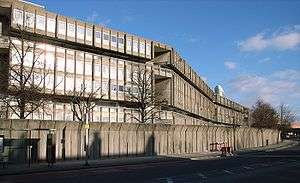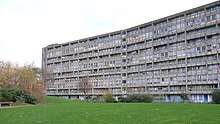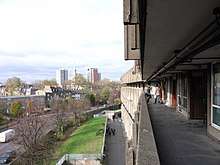Robin Hood Gardens
Robin Hood Gardens is a residential estate in Poplar, London, designed in the late 1960s by architects Alison and Peter Smithson and completed in 1972. It was built as a council housing estate with homes spread across 'streets in the sky': social housing characterised by broad aerial walkways in long concrete blocks, much like the Park Hill estate in Sheffield; it was informed by, and a reaction against, Le Corbusier's Unité d'Habitation.[1] The estate was built by the Greater London Council,[2] but subsequently the London Borough of Tower Hamlets became the landlord.
| Robin Hood Gardens | |
|---|---|
 Robin Hood Gardens | |
| General information | |
| Location | Poplar, Tower Hamlets, London, England |
| Coordinates | 51.50944°N 0.00843°W |
| Status | Western block demolished |
| Construction | |
| Constructed | 1972 |
| Demolished | 2017-2019 |
| Other information | |
| Governing body | Tower Hamlets |

The scheme, the first major housing scheme built by the Smithsons, consisted of two blocks, one of 10 and one of seven storeys; it embodied ideas first published in their failed attempt to win the contract to build the Golden Lane Estate.
A redevelopment scheme, known as Blackwall Reach, involves the demolition of Robin Hood Gardens as part of a wider local regeneration project that was approved in 2012. An attempt supported by a number of notable architects to head off redevelopment by securing listed status for the estate was rejected by the government in 2009. The demolition of the western block began in December 2017. The eastern block, which is still inhabited by tenants, is to be demolished later. The site will contain 1,575 residences.[3]
Part of the building has been preserved by the Victoria and Albert Museum[4] and was presented at the Venice Architecture Biennale in 2018.[5]
Location

The Robin Hood Gardens estate was on a tight site, in Poplar, in east London. To the south is Poplar High Street, and then the A1261; to the north Woolmore Street, then the A13 East India Dock Road; to the west is Cotton Street, which links the A13 to the Isle of Dogs and Canary Wharf, while to the east is Robin Hood Lane and the A102 Blackwall Tunnel Northern Approach Road.
In 1885 the insanitary back-to-back slums were replaced by seven tenement blocks known as Grosvenor Buildings. These were demolished in 1965, whereupon five acres became available linking other brownfield space.[1]
The complex was at the north end of the Blackwall Tunnel, where a station of the Docklands Light Railway was built in the 1990s to link the City of London to Canary Wharf. It was within sight of the nearby Balfron Tower, both highly visible examples of Brutalist architecture.
Description



Design philosophy
The Smithsons were influential architects from the Architectural Association group, who had failed to win the Golden Lane Estate contract, but published and promoted their radical design. They proposed that the building was not the fundamental unit of architecture but it was the network of pathways that was. They did not place buildings on a fixed rectilinear grid as was normal for modernist buildings, but on pathways used by the residents. They saw the needs of the pedestrian were different from those of the motorist and the service vehicle. Pathways in the sky had been used before by architects, such as Michiel Brinkman’s Spangenblok Housing (1912) in Rotterdam,[6] but it was tied to the existing street pattern, and the pathways the Smithsons proposed to use in Golden Lane were independent and non-rectilinear. Robin Hood Gardens was a physical implementation of these earlier principles.[7]
Estate
The estate consisted of two long curved blocks facing each other across a central green space, and in total covered 1.5 hectares (3.7 acres). The blocks were of ten storeys (east) and seven storeys (west), built from precast concrete slab blocks and contain 213 flats. Construction began in 1968, the first flats opened in 1971, and the scheme as a whole was completed in 1972 at a cost of £1,845,585. In the central green area was a small man-made hill.[1]
Living space
The flats themselves were a mixture of single-storey apartments and two-storey maisonettes, with two to six bedrooms. The maisonettes were designed with the bedrooms facing inwards shielding the residents from the traffic noise. Another design feature was the wide balconies (the "streets") on every third floor, the concept being to provide public space which would encourage interaction. Alcoves called "pause spaces" were provided next to the entrance doorways on the "streets" which the Smithsons hoped the residents would personalise and where children would play.[1] As with many other council housing blocks in the UK, tenures diversified somewhat and included social housing tenants, leaseholders who exercised the right to buy and subsequent private owners, and private tenants of leaseholders.[8]
Reception
The design of the estate contained many flaws. The "streets in the sky" concept often did not work in practice. The walkways and especially the enclosed stairwells contained numerous blind spots, including the alcoves in front of doors (the architects called them pause places). Unlike a true city street, there was a lack of regular passers-by to act as a deterrent to crime and disorder. This is the concept referred to as "eyes on the street" by Jane Jacobs in The Death and Life of Great American Cities. This was because the walkways were not thoroughfares and mostly ended with an above-ground dead end. As a result, the only people who shared the walkways with their residents were the drug dealers and muggers who preyed on them. Furthermore, a resident could not easily escape trouble if they encountered it in the walkway.[9]
The exposed concrete weathered poorly, and by the time of demolition was in poor repair.[10] The site was also cut off from its surroundings by roads, and the design decision to turn the entire development inwards - a situation worsened by surrounding it with a prison-like concrete wall - meant that the possibility of any saving grace of a positive relationship with its surroundings was lost.
A doctoral thesis from 1982 gives a damning verdict: "The access to the building is, to our mind, ill-conceived: the ‘stress-free’ zone is abused: the lack of common privacy is a constant worry: the vicious writing-on-the-wall is hard to ignore, and is undeniably related to much of the mindless vandalism that has broken down the communal facilities. The tenants do not make use of the decks and, consequently, the idea of ‘street’ does not have any factual validity…[Our] final assessment must be that, socially, the building does not work. The lucidly argued Smithson aesthetic fails at Robin Hood."[11]
Redevelopment plans
The Council declared the site to be part of a larger regeneration area named Blackwall Reach, bounded by East India Dock Road to the north, the Blackwall Tunnel Northern Approach (A102) and East India Docks to the east, Aspen Way to the south and Cotton Street to the west.[12] It plans to provide 1,575 new homes across an expanded area along with improvements to the primary school, a new park and other community facilities. Only 698 of the units (45%) will be "affordable"[13]
In April 2010, Tower Hamlets shortlisted groups of architects, housing associations and developers to undertake the £500 million project.[14] Before the final announcement, the designs for replacement buildings were condemned in The Observer as "generic developers' fare, with... no sense of place".[15]
Swan Housing Association was selected, with a plan to replace the current estate of 252 homes with up to 1,700, of which 700 would be for social housing and shared ownership. It would also include open space, community facilities, and better connections to the surrounding area.[16]
The demolition plans were passed by Tower Hamlets Council on 15 March 2012.[17] Final planning approval for the redevelopment scheme was given in December 2012.
There was a lengthy period clearing the flats of their residents — both tenants and owners who had taken advantage of Right to Buy. A case study published in The Big Issue magazine shows one owner was offered £178,000 by the council for her two-bedroom flat at Robin Hood Gardens, when an equivalent property in Poplar would cost £347,000. If she accepted a shared ownership proposal, it would be seven years before she regained full ownership.[18]
Preservation attempts
First campaign
A campaign was mounted in 2008 by Building Design magazine and the Twentieth Century Society to get Robin Hood Gardens listed as a historical landmark in order to save it from destruction, with support from Richard Rogers and the late Zaha Hadid;[19][20] the latter counted it as her favourite building in London.[21] However, English Heritage did not back the proposal, with its commissioners overruling the advice of its own advisory committee.[22] This was because it did not fully meet the strict criteria for listing post-war buildings, and because the building's design had suffered serious shortcomings from the start, for the designers had been forced to compromise on various issues, including the width of the access decks.[23]
The campaign to save Robin Hood Gardens drew very little support from those who actually had to live in the building, with more than 75% of residents supporting its demolition when consulted by the local authority.[24] A resident's own survey, published in Building Design in June 2009, found that 80% of residents wanted it refurbished.[25] In October 2009, opposition councillor Tim Archer (Conservative) accused the Council of ignoring maintenance problems to encourage residents to move out.[26]
In May 2009 the Minister of Culture, Andy Burnham, reiterated an earlier government decision not to list the estate and also granted a Certificate of Immunity from listing, meaning that the structure could not be reconsidered for listing for at least five years.[27] This ministerial decision endorsed the recommendation of English Heritage that Robin Hood Gardens "fails as a place for human beings to live" and did not deserve statutory heritage protection, leaving the way open for Tower Hamlets Council to proceed with its demolition and redevelopment.[27]
Second campaign
After the expiry of a five-year listing immunity, a second application to have it listed was made by the Twentieth Century Society and again was supported by many architects, including the Smithsons' son Simon Smithson; this was rejected by Historic England in 2015. Demolition of the western block began in August 2017. The eastern block still has tenants and is to be demolished later.[28]
V&A preservation
The Victoria and Albert Museum has salvaged a three-storey section of Robin Hood Gardens. It has added two sections of the estate's garden and street-facing facades, including one of its elevated walkways that were central to the Smithsons "streets in the sky" concept. The section of the facade reaches almost 9 metres in height and 5.5 metres in width, representing a full section of the repeating pattern of prefabricated parts that form the buildings' faces. Original fittings, including cabinetry that forms some of the interior walls, are included.[29]
The Smithsons on their work
The project was the subject of a BBC documentary The Smithsons on Housing (1970), made by B. S. Johnson, in which both Smithsons are interviewed. The Smithsons reflected on the role of the architect, and how in the twentieth century they have been required to implement several visions. In the 1920s, the need had been for garden cities isolated from the industrialised city, this was followed for the need for sun filled high rise flats isolated and separated from the services on the ground. To reconnect families with each other, the Smithsons designed streets in the air that were to emulate the terraced housing of the Georgian period; they would, by design, block out the noise and look over a green central communal area.[30]
Although Peter Smithson admitted he had been driven by a combination of urgency, practicality and idealism, he claimed in a 1990s interview that the project had failed, although he largely blamed social issues rather than architectural ones for this failure.[31]
"In other places you see doors painted and pot plants outside houses, the minor arts of occupation, which keep the place alive. In Robin Hood you don't see this because if someone were to put anything out it people will break it."
Asked why he felt this was the case, Smithson cited "social jealousy".[31]
See also
References
- "Robin Hood Gardens, Poplar: 'an exemplar – a demonstration of a more enjoyable way of living'". Municipal Dreams. 4 February 2014. Retrieved 11 November 2017.
- "V&A · Robin Hood Gardens". Victoria and Albert Museum. Victoria and Albert Museum. Retrieved 12 November 2017.
- Jessica Mairs, "Bulldozers move in on Robin Hood Gardens", Dezeen, 25 August 2017.
- "V&A acquires a fragment of Brutalist architecture". IanVisits. 10 November 2017.
- "'Ruins' of a London landmark resurrected in Venice". CNN Style. 23 May 2018. Retrieved 25 September 2018.
- "Spangen Quarter Housing". www.hiddenarchitecture.net. Retrieved 11 November 2017.
- Dutton, John (26 July 2013). "Featured Plan: Smithsons' Golden Lane Project (1952) - GRIDS blog". GRIDS blog. USC School of Architecture. Retrieved 11 November 2017.
- Harris, John (4 January 2016). "The end of council housing". The Guardian. Retrieved 13 November 2017.
- https://www.academyofurbanism.org.uk/streets-in-the-sky-the-urban-idiot/
- https://www.theguardian.com/artanddesign/2010/dec/05/robin-hood-gardens-east-london
- John Furse, The Smithsons at Robin Hood, University of Sussex PhD, 1982
- Blackwall Reach Archived 13 April 2009 at the UK Government Web Archive at English Partnerships website (2008)
- Forrest, Adam (23 August 2017). "Robin Hood Gardens: Demolition of iconic London housing estate begins". The Big Issue. Retrieved 10 November 2017.
- More vie to redevelop Robin Hood Gardens, Building Design, 23 April 2010
- Rowan Moore, Robin Hood Gardens: don't knock it… down, The Observer, 3 December 2010.
- Kvist, Else (9 January 2012). "1960s housing estate, Robin Hood Gardens, to be transformed". Docklands & East London Advertiser. Retrieved 13 January 2012.
- Simmonds, Carl (30 May 2013). "Robin Hood Gardens". Architectuul. Retrieved 6 July 2013.
- Forrest, Adam (21 March 2016). "Robin Hood Gardens and the end of council housing". The Big Issue. Retrieved 10 November 2017.
- Building Design campaign to save Robin Hood Gardens, Building Design, 21 February 2008
- Don't knock brutalism, The Guardian, 26 June 2008
- Evening Standard Magazine, 18 May 2012
- English Heritage fails to back Robin Hood Gardens, Building Design, 8 May 2008
- Robin Hood Gardens: The videos for and against, Building Design, April 2009
- Row over 'street in sky' estate, BBC, 7 March 2008
- New Robin Hood Gardens residents survey challenges demolition, Building Design, 26 June 2009. Retrieved 2010-03-27
- "Council running down Robin Hood Gardens" Building Design, 2009-09-25. Retrieved 2010-03-27
- Hill, John (15 May 2009). "Robin Hood Gardens not to be listed". Wharf. Retrieved 6 July 2013.
- Jessica Mairs, "Bulldozers move in on Robin Hood Gardens", Dezeen, 25 August 2017.
- Mairs, Jessica (9 November 2017). "V&A acquires entire maisonette from Robin Hood Gardens". Dezeen. Retrieved 10 November 2017.
- Sukhdev Sandhu "You're Human Like The Rest Of Them – the NFT's celebration of BS Johnson", telegraph.co.uk, 16 June 2009
- Rebuilding Britain for the Baby Boomers, introduced by Maxwell Hutchinson, BBC Radio 4, 26 November 2011
External links
| Wikimedia Commons has media related to Robin Hood Gardens. |
- Johnson, B.S. (1970). "The Smithsons on Housing". BBC, delivered by YouTube. Retrieved 11 November 2017. Primary source. Alison and Peter Smithson interviewed
- Robin Hood Gardens: Out of Time
- Reflections on Robin Hood Gardens and Brutalist Architecture in East London
- Meet the Smithsons
- Information from the Twentieth Century Society on the campaign to protect Robin Hood Gardens
- The Brutalist Truth, TheThirdEstate.net, 24 May 2009